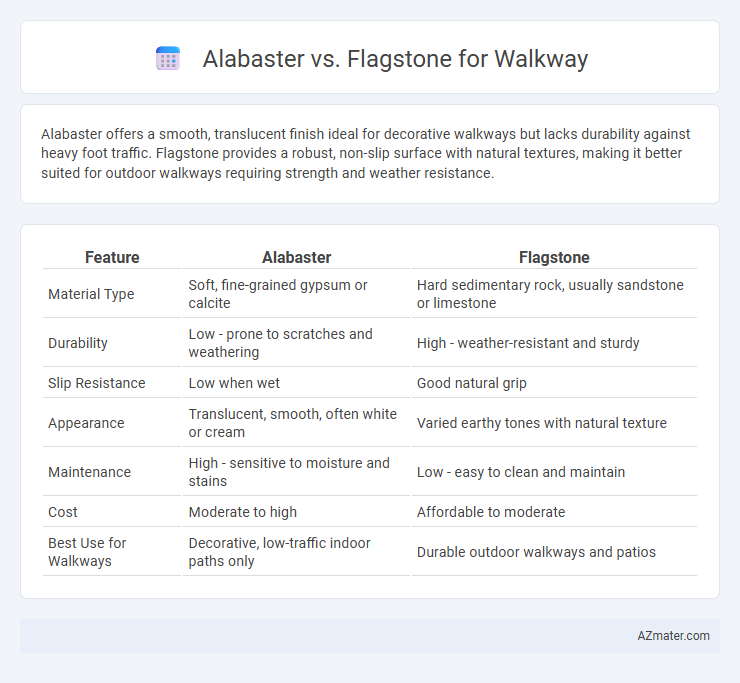Alabaster offers a smooth, translucent finish ideal for decorative walkways but lacks durability against heavy foot traffic. Flagstone provides a robust, non-slip surface with natural textures, making it better suited for outdoor walkways requiring strength and weather resistance.
Table of Comparison
| Feature | Alabaster | Flagstone |
|---|---|---|
| Material Type | Soft, fine-grained gypsum or calcite | Hard sedimentary rock, usually sandstone or limestone |
| Durability | Low - prone to scratches and weathering | High - weather-resistant and sturdy |
| Slip Resistance | Low when wet | Good natural grip |
| Appearance | Translucent, smooth, often white or cream | Varied earthy tones with natural texture |
| Maintenance | High - sensitive to moisture and stains | Low - easy to clean and maintain |
| Cost | Moderate to high | Affordable to moderate |
| Best Use for Walkways | Decorative, low-traffic indoor paths only | Durable outdoor walkways and patios |
Introduction to Walkway Materials
Alabaster and flagstone are popular choices for walkway materials, each offering unique aesthetic and functional qualities. Alabaster provides a smooth, translucent surface that enhances light reflection, ideal for modern, elegant designs. Flagstone features natural, irregular shapes with a rugged texture, making it durable and perfect for rustic or natural-looking pathways.
Overview of Alabaster and Flagstone
Alabaster is a soft, translucent stone primarily composed of gypsum or calcite, known for its smooth texture and elegant appearance, making it ideal for decorative walkways. Flagstone, on the other hand, is a durable, sedimentary rock commonly made of sandstone, limestone, or slate, valued for its strength, natural flatness, and varied earthy tones suitable for heavy foot traffic. Choosing between alabaster and flagstone for a walkway depends on aesthetic preferences and durability requirements, with flagstone offering superior resilience for outdoor use.
Visual Appeal: Alabaster vs Flagstone
Alabaster walkways offer a smooth, luminous finish with a consistent creamy-white tone that enhances modern and minimalist landscaping designs. Flagstone features a natural, rugged texture and a variety of earthy colors, providing a rustic and organic aesthetic ideal for traditional and garden pathways. The choice between alabaster and flagstone significantly impacts the visual atmosphere, with alabaster promoting elegance and flagstone emphasizing natural character.
Durability and Longevity Comparison
Alabaster, a softer and more porous mineral, generally offers lower durability and longevity compared to flagstone, which is a dense, sedimentary rock known for its hardness and resistance to wear. Flagstone's natural cleft surface provides excellent slip resistance and withstands heavy foot traffic and weathering, making it ideal for durable walkways. In contrast, alabaster may suffer from chipping and erosion over time, requiring more frequent maintenance and replacement.
Installation Process Differences
Alabaster walkways require precise cutting and polishing due to the stone's soft and translucent nature, demanding skilled craftsmanship during installation. Flagstone installation involves laying irregularly shaped, flat stones on a compacted base with mortar or sand, allowing for easier fitting and flexibility in design. The differing hardness and shape between alabaster and flagstone significantly impact the choice of tools and methods, influencing both project duration and labor intensity.
Maintenance and Cleaning Needs
Alabaster walkways require gentle cleaning with mild soap and water to prevent etching or discoloration due to their softer, porous nature, making regular sealing essential to protect against stains. Flagstone, being more durable and less porous, tolerates pressure washing and a wider range of cleaning products, reducing long-term maintenance efforts. Both materials benefit from periodic sealing to prolong lifespan, but alabaster demands more frequent care to maintain its aesthetic appeal and structural integrity.
Cost Analysis: Alabaster vs Flagstone
Alabaster walkways typically cost between $12 to $18 per square foot, offering an affordable yet elegant option compared to flagstone, which ranges from $15 to $30 per square foot due to its natural durability and varied textures. Installation expenses for alabaster are generally lower because of its uniformity and ease of cutting, while flagstone requires more labor-intensive installation, increasing overall costs. When evaluating long-term investment, flagstone's resilience against weathering and wear can reduce maintenance expenses, whereas alabaster may incur higher upkeep costs in outdoor settings.
Weather Resistance and Suitability
Alabaster is less suitable for outdoor walkways due to its softness and susceptibility to weathering, particularly in freezing or wet climates where it can crack or erode easily. Flagstone, composed of durable sedimentary rocks like sandstone or slate, demonstrates superior weather resistance, making it ideal for walkways exposed to varying weather conditions. Its natural slip resistance and robust physical properties ensure long-lasting performance and safety in outdoor environments.
Eco-Friendliness and Sourcing
Alabaster is less commonly used in walkways due to its softer nature and limited durability, often sourced through environmentally intensive mining processes, impacting its eco-friendliness. In contrast, flagstone is a durable, natural sedimentary rock typically quarried with minimal environmental disruption, making it a more sustainable choice for walkways. Flagstone's availability in local regions helps reduce transportation emissions, enhancing its ecological benefits compared to alabaster.
Choosing the Right Material for Your Walkway
Choosing between alabaster and flagstone for a walkway depends on durability, appearance, and maintenance requirements. Alabaster offers a smooth, translucent surface ideal for decorative, low-traffic paths but is softer and prone to weathering. Flagstone, known for its rugged texture and durability, withstands heavy foot traffic and outdoor elements, making it suitable for high-traffic walkways.

Infographic: Alabaster vs Flagstone for Walkway
 azmater.com
azmater.com